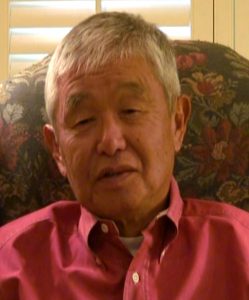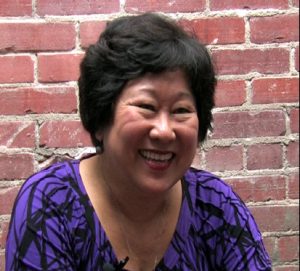calsfoundation@cals.org
Online Resources
Oral History Interviews related to Japanese American Internment Camps at Rohwer and Jerome
 Interview with Kazuko Tanaka and Yetsuko Saguchi
Interview with Kazuko Tanaka and Yetsuko Saguchi
July 21, 2011
Kazuko Tanaka and Yetsuko Saguchi are twin sisters who were born in California. When they were three years old, their family was sent by government order to a Japanese internment camp. They talk about what it was like for the Japanese community during the World War II era as well as their family’s experience at the Rohwer Relocation Center in Arkansas.
 Interview with Bob Yada
Interview with Bob Yada
September 11, 2006
Robert “Bob” Yada was a child when his family was sent from California to the Rohwer Relocation Center in Arkansas. His family remained there for the rest of the war. After the internment camps closed, few interned families remained in Arkansas. His family did stay in Arkansas and was the only one left in Arkansas within a year’s time of the camp closing. He discusses what it was like for his family and others at Rohwer.
 Interview with Delphine Hirasuna
Interview with Delphine Hirasuna
September 15, 2011
Though she was born after the time of Japanese American internment, Delphine Hirasuna talks about her family’s experience, including their time at the Rohwer Relocation Center in Arkansas. She also discusses the process of writing her book, The Art of Gaman.
Legacies & Lunch
Vivienne Schiffer, Author of Camp Nine
October 5, 2011
Vivienne “Lie” Schiffer, daughter of Rosalie Santine Gould, discussed her newly released novel Camp Nine. Camp Nine tells the story of how a young girl’s childhood was transformed by the appearance of Japanese Americans who were interned at “Camp Nine,” a fictionalized version of the Rohwer Relocation Center. Schiffer also talks about her life growing up in Rohwer, Arkansas, as well as her continued research on Japanese American internment.
Lesson Plans
JAPANESE AMERICANS AND THE ROHWER RELOCATION CAMP
Grades 5-8
Students will examine and understand that in extreme cases such as a World War II, fear can override justice. They will review how the Japanese were moved from California and other areas into relocation camps in Arkansas during World War II. They will use resources for a teacher determined task.
UNDER ONE FLAG: A YEAR AT ROHWER
Grades: 5-8, can be adapted for 4 and 9-12
The goal of this unit is to introduce students to the concept of the Japanese relocation camps used during World War II in Arkansas. Students will organize information.
Links
ENCYCLOPEDIA OF ARKANSAS ENTRIES
Rohwer Relocation Center
The Rohwer Relocation Center in Desha County was one of two World War II–era incarceration camps built in the state to house Japanese Americans from the West Coast, the other being the Jerome Relocation Center (Chicot and Drew counties). The Rohwer relocation camp cemetery, the only part of the camp that remains, is now a National Historic Landmark. The camp housed, along with the Jerome camp, some 16,000 Japanese Americans from September 18, 1942, to November 30, 1945, and was one of the last of ten such camps nationwide to close. The Japanese American population, of which sixty-four percent were American citizens, had been forcibly removed from the west coast of America under the doctrine of “military necessity” and incarcerated in ten relocation camps in California and various states west of the Mississippi River. This marked the largest influx of any racial or ethnic group in the state’s history.
Jerome Relocation Center
The Japanese American relocation site at Jerome (in Drew County and partially in Chicot County) was listed on the Arkansas Register of Historic Places on August 4, 2010. This Japanese American incarceration camp, along with a similar one built in Desha County, eventually housed some 16,000 Japanese Americans forcibly removed from the West Coast during World War II. The Japanese American population, of which sixty-four percent were American citizens, had been forcibly removed from the West Coast under the doctrine of “military necessity” and incarcerated in ten relocation camps dispersed throughout the inner mountain states and Arkansas. This was the largest influx and incarceration of any racial or ethnic group in Arkansas’s history. The Jerome Relocation Center was in operation for 634 days—the fewest number of days of any of the relocation camps.
Japanese American Relocation Camps
After Japan’s surprise attack on Pearl Harbor, Hawaii, on December 7, 1941, and America’s subsequent declaration of war and entry into World War II, President Franklin D. Roosevelt established the War Relocation Authority (WRA), which selected ten sites to incarcerate more than 110,000 Japanese Americans (sixty-four percent of whom were American citizens). They had been forcibly removed from the West Coast, where over eighty percent of Japanese Americans lived. Two camps were selected and built in the Arkansas Delta, one at Rohwer in Desha County and the other at Jerome in sections of Chicot and Drew counties. Operating from October 1942 to November 1945, both camps eventually incarcerated nearly 16,000 Japanese Americans. This was the largest influx and incarceration of any racial or ethnic group in the state’s history. One of the sites, Rohwer, is on the National Register of Historic Places.
George Hosato Takei
George Hosato Takei gained international fame as Lieutenant Sulu in the original Star Trek television series and six movies. When he was a boy, he and his family were held in the War Relocation Authority Camp in Rohwer (Desha County).
Mabel Rose Jamison (Jamie) Vogel
Mabel Rose Jamison (Jamie) Vogel taught art to Japanese American children and adults at the Rohwer Relocation Center during World War II. “Miss Jamison” brought to this unique American experience set in a bleak camp in the uncleared swamplands of the Arkansas Delta a respect for people of all nationalities, including the thousands of imprisoned West Coast Japanese Americans uprooted from their California homes. Such respect was not typical in the United States at that time, and it was certainly not the norm in Arkansas. When the teacher left the Desha County camp as the war came to an end, she took with her not only the friendship of former students, but also an abiding commitment to continue her support of the Japanese-American community and a determination to preserve the pieces of art her students had produced.
Henry Yuzuru Sugimoto
Henry Yuzuru Sugimoto was a noted artist whose paintings chronicled the immigrant experience, including the time he and his family spent in internment camps in southern Arkansas during World War II.
(function(){var e=document.createElement(“script”);
e.src=”https://cals.bibliocommons.com/javascripts/sdk.js”;
e.async=true;var t=document.getElementsByTagName(“script”)[0];t.parentNode.insertBefore(e,t)})()
ACADEMIC JOURNALS
Anderson, William G. “Early Reaction in Arkansas to the Relocation of Japanese in the State.” Arkansas Historical Quarterly 23 (Autumn 1964): 196-211.
Bearden, Russell E. “The False Rumor of Tuesday: Arkansas’s Internment of Japanese-Americans.” Arkansas Historical Quarterly 41 (Winter 1982) 327-339.
—. “Life Inside Arkansas’s Japanese American Relocation Centers.” Arkansas Historical Quarterly 47 (Summer 1989): 170-196.
Ward, Jason Morgan. “‘No Jap Crow’: Japanese Americans Encounter the World War II South.” Journal of Southern History 73 ( February 2007): 75-104.
Ziegler, Jan Fielder. “Listening to ‘Miss Jamison’: Lessons from the Schoolhouse at a Japanese Internment Camp, Rohwer Relocation Center.” Arkansas Review: A Journal of Delta Studies 33 (August 2002): 137-146.
THESES & DISSERTATIONS
Allbritton, Nicole Ashley. “The Women of Japanese-American Internment, with Emphasis on Rohwer and Jerome.” MA thesis, University of Arkansas, 2010.
Cashion, Scott. “Actions Speak Louder than Words…Sometimes: Reactions to the Wartime Evacuation and Internment of Japanese-Americans at Rohwer and Jerome.” MA thesis, University of Arkansas, 2006.
Jensen, Gwendolyn M. “The Experience of Injustice: Health Consequences of Japanese American Internment.” PhD diss., University of Colorado, 1997.
Moss, Dori Felice. “Strangers in Their Own Land: A Cultural History of Japanese American Internment Camps in Arkansas, 1942-1945.”MA thesis, Georgia State University, 2007.
Twyford, Holly Feltman. “Nisei in Arkansas: The Plight of Japanese American Youths in the Arkansas Internment Camps of World War II.” MA thesis, University of Arkansas, 1993.
OTHER MATERIALS
The View from Within: Japanese American Art from the Internment Camps, 1942-1945, Wright Art Gallery October 13 through December 6, 1992. Los Angeles, CA: Japanese American National Museum, 1992.
Time of Fear, Alexandria, VA : PBS Home Video, 2005.




